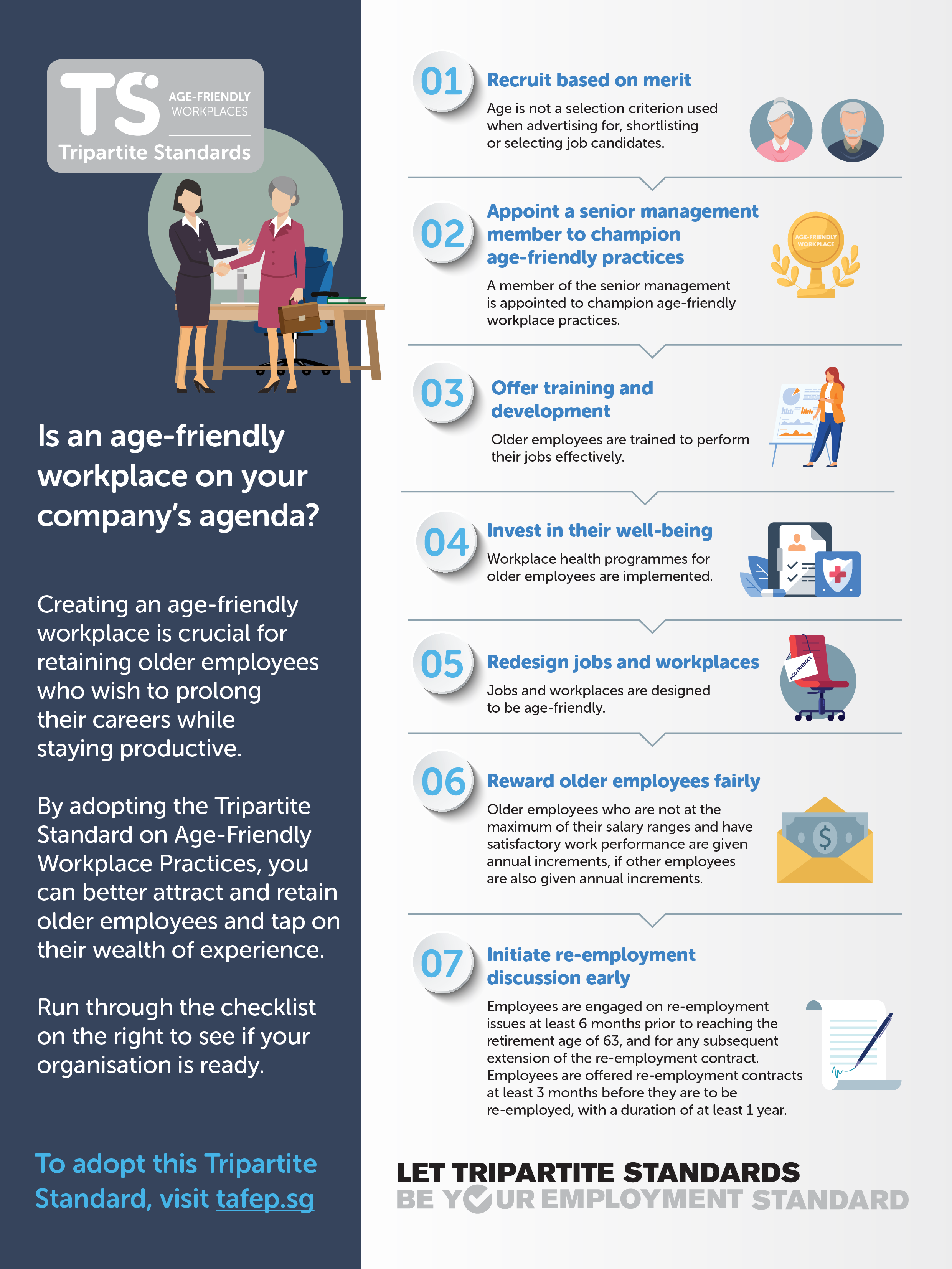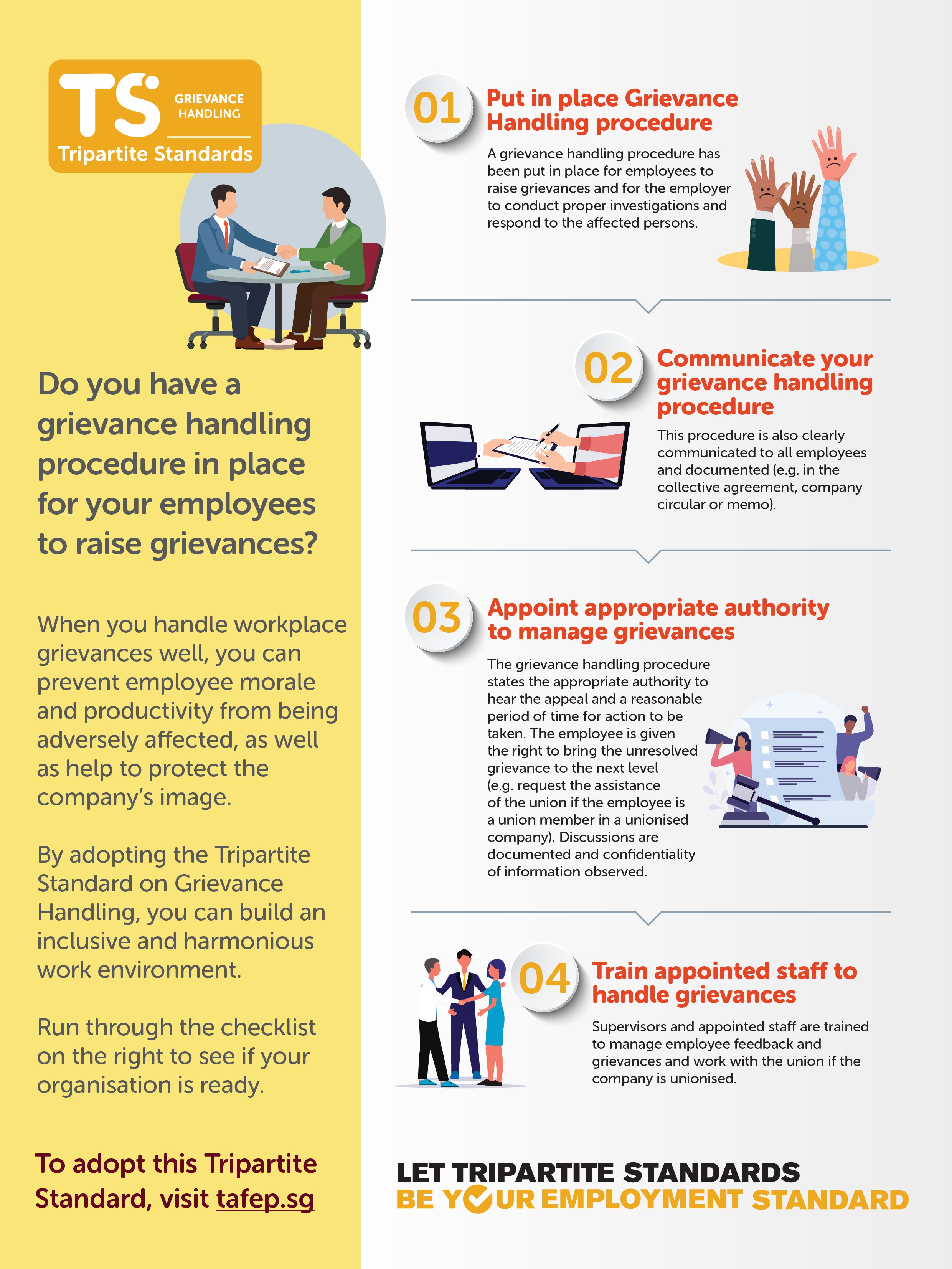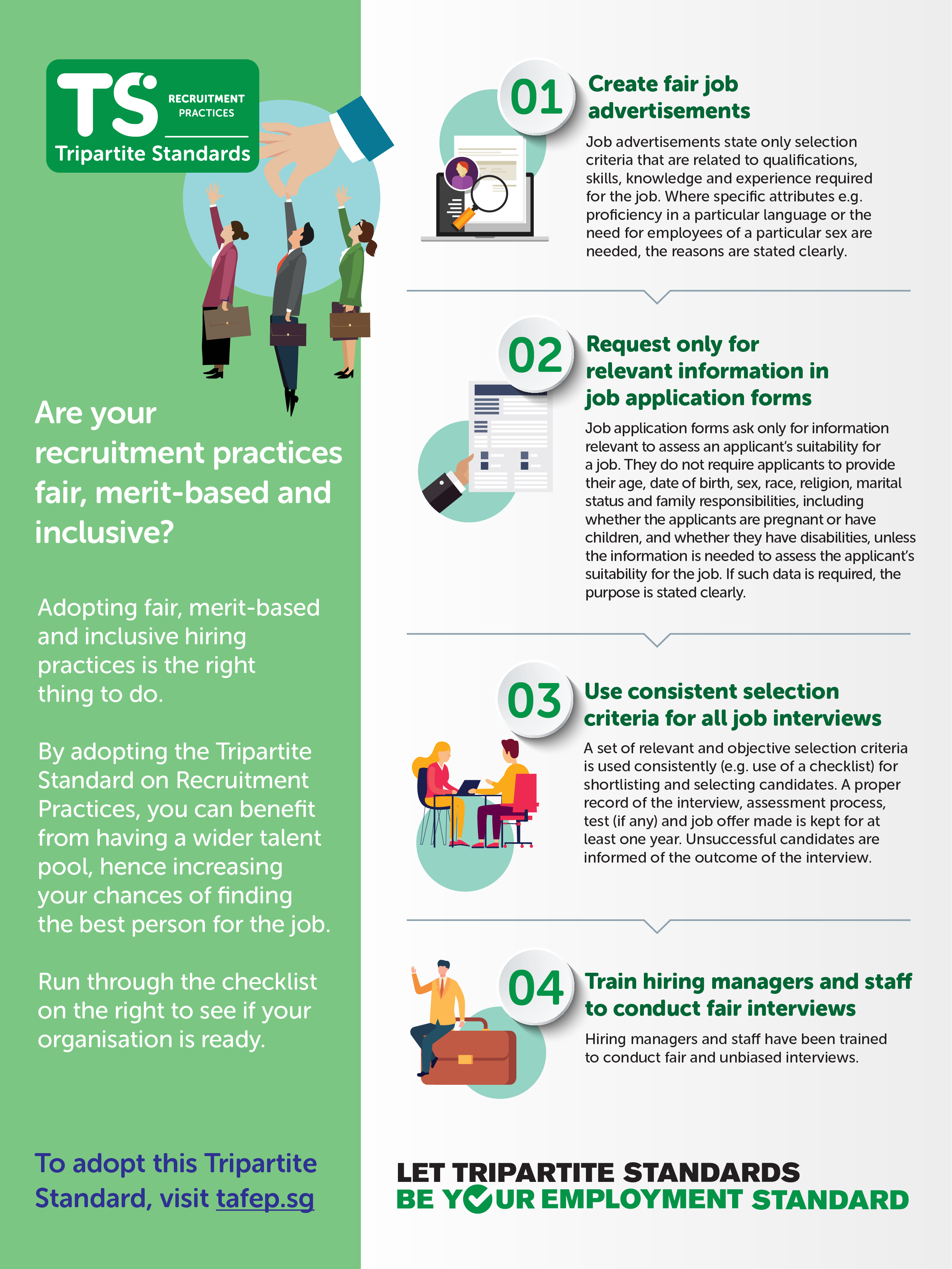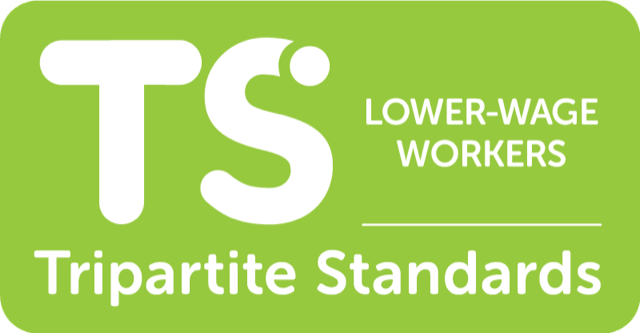Age-Friendly Workplace Practices

The Tripartite Standard on Age-Friendly Workplace Practices specifies a set of good age management practices that all employers should implement at the workplace.
Purpose of this Tripartite Standard
-
Many older employees would want to work longer and stay productive if the workplace is conducive and inclusive. Age-friendly workplaces also help employers attract and retain these employees and tap on their wealth of experience.
Practices you need to adopt for this Tripartite Standard
-
Age is not a selection criterion used when advertising for, shortlisting or selecting job candidates.
-
A member of the senior management is appointed to champion age-friendly workplace practices.
-
Older employees are trained to perform their jobs effectively.
-
Workplace health programmes 1 for older employees are implemented.
-
Jobs and workplaces are designed 2 to be age-friendly.
-
Older employees who are not at the maximum of their salary ranges and have satisfactory work performance are given annual increments, if other employees are also given annual increments.
-
Employees are engaged on re-employment issues at least 6 months prior to reaching the retirement age of 63, and for any subsequent extension of the re-employment contract. Employees are offered re-employment contracts at least 3 months before they are to be re-employed, with a duration of at least 1 year.
Notes
-
Older employees refer to employees aged 60 and above.
-
Training refers to work-related structured training which includes classroom training, private lessons, workshops, seminars, structured on-the-job training (e.g. training by supervisors or co-workers), e-learning (systematic training programmes via e-platforms), traineeship programmes, apprenticeship training and mandatory course
-
Job Redesign refers to the review and reorganisation of job responsibilities, to improve employee productivity and satisfaction. All companies will need to demonstrate that the design of the jobs and workplace meets the following three criteria for the older employees:
-
-
Easy – makes the work physically easy. These could include the use of larger screen displays, substituting manual strength for mechanical and reducing strenuous activities.
-
Safe – minimises the risk of injuries at work. These could include the installation of handrails and lights along travel routes, slip-resistant walking surfaces and ergonomic office chairs.
-
Smart – frees up time for knowledge-based activities. These could include the use of technology to automate routine tasks and re-training of employees to operate machines instead.
1 Examples include implementing ergonomics intervention programme, briefings on choosing healthier food options, exercise programmes and regular body check-ups.
2 Companies may tap on the WorkPro grants for funding support or refer to the Job Redesign Toolkit to learn more about job redesign.
Tripartite Standard on Age-Friendly Workplace Practices Infographic summarises the 7 practices you need in order to adopt this Tripartite Standard.

View or download the Tripartite Standard on Age-Friendly Workplace Practices Infographic.
Contracting with Self Employed Persons

The Tripartite Standard on Contracting with Self-Employed Persons specifies a set of fair and progressive employment practices for service contracts that all service buyers should implement at the workplace.
Purpose of this Tripartite Standard
-
The growth of the platform economy creates opportunities for businesses, consumers and workers, in particular self-employed persons (SEPs) 1 . To ensure the sustainability of the economy of self-employed work, businesses whether as service buyers or intermediaries 2 , and SEPs must fulfil their obligations.
-
Businesses should set out their arrangement with SEPs clearly to lend clarity to the expectations and conduct of the relationship. Clearer obligations and duties foster better working relationships between businesses and SEPs, and enable SEPs to provide better services. SEPs on their part should fulfil their obligations and duties in a responsible manner.
Practices you need to adopt for this Tripartite Standard
-
Terms of products or services to be delivered are discussed with SEPs. The terms agreed upon are documented in written key terms and provided to SEPs before any products or services are delivered.
-
The written key terms are set out clearly and include the following:
-
-
Names of contracting parties;
-
Parties’ obligations, such as nature of services to be provided (e.g. outcome; duration; location);
-
Payment
-
Amount of payment due for each product or service (or part thereof);
-
Due date of payment(s) (e.g. a fixed number of days after the SEP issues an invoice for delivered services or milestones, or periodic payments for services rendered during that period);
-
If terms on variation of the agreement are provided for, how either party can vary the key terms or terminate the agreement (e.g. by mutual agreement);
-
If terms for resolving disputes are provided for, the option for mediation should be made available, without it being a barrier to either party bringing any dispute directly to the Small Claims Tribunals
Key Terms of Engagement Form Template for Self-Employed Persons (SEPs)
To shape better contracting norms and aid in the event of payment disputes, the Ministry of Manpower (MOM) has developed a key terms of engagement (Doc) for SEPs.
The form template was developed in accordance with the Tripartite Standard on Contracting with SEPs (TS SEPs), and details the key terms of engagement that should be provided in a written contract.
SEPs can use the form template to request that service-buyers provide in writing the key terms of engagement. Service-buyers who wish to provide their SEPs with written agreements, but do not know how to do so, can use the form template as a guide. Users of the form template can further customise it to suit the needs of their engagements.
In addition to the above, service-buyers who use the form template and include all suggested terms in Section A – E are ready to adopt the TS SEPs, and we encourage them to do so. MOM also encourages SEPs who use the form template to encourage their service-buyers to adopt the TS SEPs.
Employment of Term-Contract Employees

The Tripartite Standard on the Employment of Term Contract Employees specifies a set of good term-contract employment practices that all employers should implement at the workplace.
Purpose of this Tripartite Standard
-
Term contract employees form a small but important part of our workforce. Progressive employers provide such employees with leave benefits commensurate with the cumulative length of their contracts and give appropriate notice in instances of early termination or non-renewal of contract. They also ensure that term contract employees are adequately trained to perform their roles effectively.
Practices you need to adopt for this Tripartite Standard
-
All term contracts of service of 14 days or more, which are renewed within 1 month from the end of the previous contract, are treated as continuous service. The following statutory leave benefits under the Employment Act and the Child Development Co-Savings Act are awarded based on the cumulative length of such "continuous service":
-
-
Annual leave
-
Sick leave
-
Maternity leave
-
Paternity leave
-
Adoption leave
-
Child-care leave and extended child-care leave
-
In instances of early termination or non-renewal of the term contract, the cumulative length of service is used for purposes of calculating the notice period, as follows:
| Cumulative length of service |
Notice period shall not be less than |
| Less than 26 weeks |
1 day |
| At least 26 weeks but less than 2 years |
1 week |
| At least 2 years but less then 5 years |
2 weeks |
| At least 5 years |
4 weeks |
-
Employees are trained 1 to perform their jobs effectively.
Notes
-
Term contract employees are those who are on fixed-term contracts of employment that will terminate upon the expiry of a specific term unless it is renewed.
Flexible Work Arrangements

The Tripartite Standard on Flexible Work Arrangements (TS-FWA) was discontinued on 1 December 2024, replaced by the Tripartite Guidelines on Flexible Work Arrangement Requests (TG-FWAR). Companies that have adopted TS-FWA will still be recognised as adopters and may continue using the TS-FWA logo.
The Tripartite Guidelines on Flexible Work Arrangement Requests set out how employees should request for FWAs and use them, and how employers and supervisors should handle FWA requests. Learn more about TG-FWAR here.
Grievance Handling

The Tripartite Standard on Grievance Handling specifies a set of good grievance handling practices that all employers should implement at the workplace.
Purpose of this Tripartite Standard
-
Singapore’s workforce is inherently diverse. Companies with a diverse workforce benefit from having a larger talent pool and a competitive edge. However, miscommunication and misunderstanding can occur in a diverse workplace. If not managed well, employee morale and productivity, as well as the company’s operations and image, can be adversely affected. Employers can put in place policies and procedures to manage workplace grievances and build an inclusive and harmonious workplace.
Practices you need to adopt for this Tripartite Standard
-
A grievance handling procedure has been put in place for employees to raise grievances and for the employer to conduct proper investigations and respond to the affected persons.
-
This procedure is also clearly communicated to all employees and documented (e.g. in the collective agreement, company circular or memo).
-
The grievance handling procedure states the appropriate authority to hear the appeal and a reasonable period of time for action to be taken. The employee is given the right to bring the unresolved grievance to the next level (e.g. request the assistance of the union if the employee is a union member in a unionised company). Discussions are documented and confidentiality of information observed.
-
Supervisors and appointed staff are trained 1 to manage employee feedback and grievances and work with the union if the company is unionised.
Implementation Guide for employers to adopt the Tripartite Standard on Grievance Handling
Learn how your organisation can put in place practices specified by the Tripartite Standard on Grievance Handling with this Implementation Guide.
Notes
-
Workplace grievances refer to discontent or feelings of unfairness at work. It may be felt by an individual employee or a group of employees (e.g. a wage cut or a retrenchment exercise that could involve several employees or the entire workforce).
Tripartite Standard on Grievance Handling Infographic summarises the 4 practices you need in order to adopt this Tripartite Standard.

View or download the Tripartite Standard on Grievance Handling Infographic.
Recruitment Practices

The Tripartite Standard on Recruitment Practices specifies a set of good recruitment practices that all employers should implement at the workplace.
Purpose of this Tripartite Standard
-
Adopting fair, merit-based and inclusive hiring practices is the right thing to do. Employers also benefit from having a wider pool of candidates to recruit from, hence increasing their chances of finding the best person for the job and strengthening the organisation.
Practices you need to adopt for this Tripartite Standard
Job Advertisements
-
Job advertisements state only selection criteria that are related to qualifications, skills, knowledge and experience required for the job. Where specific attributes e.g. proficiency in a particular language or the need for employees of a particular gender are needed, the reasons are stated clearly.
Job Application Forms
-
Job application forms ask only for information relevant to assess an applicant’s suitability for a job. They do not require applicants to provide their age 1, date of birth, gender, race, religion, marital status and family responsibilities, including whether the applicants are pregnant or have children, and whether they have disabilities, unless the information is needed to assess the applicant’s suitability for the job. If such data is required, the purpose is stated clearly.
Job Interviews
-
A set of relevant and objective selection criteria is used consistently (e.g. use of a checklist) for shortlisting and selecting candidates. A proper record of the interview, assessment process, test (if any) and job offer made is kept for at least one year. Unsuccessful candidates are informed of the outcome of the interview.
-
Hiring managers and staff 2 have been trained 3 to conduct fair and unbiased interviews.
Implementation Guide for employers to adopt the Tripartite Standard on Recruitment Practices
Learn how your organisation can put in place practices specified by the Tripartite Standard on Recruitment Practices with this Implementation Guide.
Tripartite Standard on Recruitment Practices Infographic summarises the 4 practices you need in order to adopt this Tripartite Standard.

View or download the Tripartite Standard on Recruitment Practices Infographic.
Unpaid Leave for Unexpected Care Needs

The Tripartite Standard on Unpaid Leave for Unexpected Care Needs specifies good caregiving leave practices that all employers should implement at the workplace.
Purpose of this Tripartite Standard
-
Caregiving is an important responsibility and is no easy feat, especially for those who have to juggle between work and caregiving roles. At times, employees may have greater caregiving needs should their immediate family members have a medical episode and require more care. While employees are encouraged to first utilise their statutory leave, employers can be more compassionate and provide additional unpaid leave to support employees during such stressful periods. This can help employers better attract and retain employees.
Practices you need to adopt for this Tripartite Standard
-
Employees are informed of the types of unpaid leave offered, the process to request for them, and the expectations of the responsible use of leave. Employees can request for more leave if they require. Employees are notified on outcomes of leave requests in a timely manner. If a request cannot be granted, supervisors engage employees on the reasons and where possible, discuss suitable alternatives that better meet the needs of both employer and employee.
-
Employees are offered up to 4 weeks of unpaid leave per year if their child is below the age of 2 and:
-
-
is born (a) preterm, or (b) with congenital conditions, or (c) as part of multiple births; or
-
has any medical conditions, subject to discussion with the employer.
-
Employees are offered up to 2 weeks of unpaid leave per year for the caring of immediate family members who are hospitalised, during or after hospitalisation.
Notes
-
Week refers to the number of days in the work week of the employee. For example, if the employee works 5 days in a week, he/she will be offered up to 20 days of unpaid leave per year under Specification 3.
-
Immediate family members refers to parents (including in-laws), spouse, and children.
Work-Life Harmony

The Tripartite Standard on Work-Life Harmony specifies practices that employers should implement at the workplace to support employees to effectively manage responsibilities and aspirations in the spheres of work and personal life.
Adopt the Tripartite Standard (TS) on Work-Life Harmony now and you can get a FREE *Human Capital Diagnostic Tool (HCDT) worth $1600! Adopters who are interested in the HCDT can email TAFEP at ts@tafep.sg for more details. This offer is on a first come first served basis. Adopt Now.
*The complimentary diagnostic assessment (Human Capital Diagnostic Tool) will assist organisations to assess the maturity of their HR processes to better support their business needs.
Purpose of this Tripartite Standard
- Work-life harmony is achieved when an individual is able to effectively manage both work responsibilities and family/personal aspirations. This benefits both employers and employees.
- Employers have a competitive advantage as they can better attract and retain employees from a wider talent pool and improve employee morale and engagement for better work performance.
- Employees can feel sufficiently supported to effectively achieve work responsibilities as well as family and personal aspirations.
Practices you need to adopt for this Tripartite Standard
- Employer has put in place flexible work arrangements (FWAs) by:
- Offering FWAs to employees;
- Informing employees about the types of FWAs offered, the process to request for them, and the expectations on the responsible use of FWAs (e.g. in company’s staff website, HR policy, circular or memo);
- Discussing suitable alternatives that better meet the needs of both employer and employee where a request for FWA cannot be granted;
- Training supervisors* to:
- Objectively evaluate employees’ applications for FWA based on the suitability of the FWA, considering the needs of the job and the employees in areas such as work performance, job requirements', compensation and safety; and
- Set work expectations, manage and appraise employees on FWAs fairly based on work outcomes.
* Training includes programmes or training workshops for supervisors on FWAs.
- Employer has put in place employee support schemes by:
- Providing at least two employee support schemes* for all its employees, based on employees’ needs; and
- Communicate to employees the different forms of employee support schemes and the process to apply for them (e.g. in company’s staff website, HR policy, circular or memo); and
- Adopting technological tools to support work-life strategies, where relevant.
*Examples include family day, subsidised health screening, staff recreation areas etc. Other examples of employee support schemes can be found here.
- Employer has put in place enhanced leave policies for all employees by:
- Providing at least two enhanced leave benefits (e.g. compassionate leave, extended childcare leave)*; and
- Encouraging the utilisation of annual, childcare, maternity and paternity leave, as well as other leave benefits offered by employers when needed.
The different forms of leave benefits and the process to apply for them should be communicated clearly to employees (e.g. in company’s staff website, HR policy, circular or memo).
*Enhanced leave benefits refer to leave benefits offered above and beyond those which are legally required. Employers who have adopted The Tripartite Standard on Unpaid Leave for Unexpected Care Needs would be considered as offering one enhanced leave benefit. Other examples of enhanced leave benefits can be found here.
- A member of the senior management is appointed to champion Work-Life Harmony.
- Employer to discuss suitable arrangements for employees with caregiving* responsibilities that meet the needs of both employers and employees, such as:
- Option to reduce work hours upon request (with a commensurate reduction in pay); or
- Other forms of flexible work arrangements including staggered start/end times and telecommuting; or
- Additional leave provisions; or
- Flexible benefits for caregivers
*“Caregiving” refers to looking after children or provides assistance to family members who are ill, disabled, or need help with daily activities.
- Employer to establish and communicate (e.g. through employee handbook or company-wide HR communications) its work-life harmony policy to employees. This will support employees’ mental well-being, prevent potential work burnout and improve productivity.
Some examples of work-life harmony policy can be found on page 10 of the Tripartite Advisory on Mental Health and Well-being at Workplaces.
- Employer will review the effectiveness of its work-life programmes on a regular basis (e.g. through annual or bi-annual survey, focus group discussions etc).
Advancing Well-Being of Lower-Wage Workers

The Tripartite Standard on Advancing Well-Being of Lower-Wage Workers specifies a set of good practices that employers should implement at the workplace to uplift the well-being of lower wage workers.
Purpose of this Tripartite Standard
-
Lower-wage workers1 are often in jobs that need greater workplace support for training & career development and well-being needs such as health & rest. Many are also in manual jobs where they may be more exposed to injury risks. Responsible employers can significantly extend their lower-wage workers’ productive longevity, improve job retention and deepen skills by taking the simple steps outlined in this Tripartite Standard. Taking care of their needs will increase their motivation, giving workers the dignity and respect that every individual deserves.
Practices you need to adopt for this Tripartite Standard
- Employer adopts the Tripartite Standard on the Employment of Term Contract Employees (TS-TCE).
- Firms must fulfil the Progressive Wage Model (PWM)2 training requirements for workers in PWM-eligible job roles3.
- Establish and communicate to their lower-wage workers employer’s training plan4 and potential career pathway for their learning and development.
- Recognise skills and proficiency when hiring, assessing and promoting their lower-wage workers by:
- Having candidates list relevant skills in their job applications; and
- Having supervisors indicate their employees’ level of proficiency in their current roles in assessing performance and readiness for promotion.
- Provide support to help their lower-wage workers learn (e.g. time-off to go for training), without detriment to these employees.
- Attain bizSAFE Level 25 to develop capability to perform systematic risk assessment and effective risk mitigation6.
- Provide at least one Total Workplace Safety and Health module or an equivalent workplace health promotion programme addressing any of the following: chronic conditions, ergonomics, mental health, or healthier lifestyle.
- Provide access to proper and reasonable7 rest areas for lower-wage workers working in their premises, including outsourced workers8 if any.
- If it is not practicable to provide designated rest areas, such as due to space constraints, the employer should minimally ensure that these workers are provided with:
- Means to safekeep belongings; and
- Access to water for drinking.
Notes
- Lower-wage workers refer to full-time resident employees earning up to the 20th percentile gross monthly income (excluding employer CPF contributions) of full-time employed residents, which was $2,708 in 2024.
- PWMs apply to resident employees across 7 sectors (Cleaning, Security, Landscape, Lift and Escalator, Retail, Food Services, Waste Management) and 2 occupations (Administrators, Drivers).
- Firms that do not employ foreign workers and thus need not adhere to PW requirements will still need to implement this practice to adopt this Tripartite Standard.
- Employers may reference the following resources:
- SSG Skills Framework for recommendations on courses to take for individual job roles.
- OJT blueprint to implement structured on-the-job training.
Training can take the form of on-the-job training or a formal training programme conducted online or in-person. It can also include cross-cutting courses outside of the worker’s current job role, as long as employers assess that they help the worker add value to the company.
Unionised companies may also consult their union leaders through the Company Training Committee (CTC) platform to determine the appropriate training for workers, or take steps to establish a CTC.
- bizSAFE Level 2 is valid for 6 months, and is non-renewable. Firms are strongly encouraged to progress to Level 3 to remain on bizSAFE thereafter; however, this will not be required for firms to continue as adopters of this Tripartite Standard.
- SMEs from low-to-medium risk industry sectors can attain bizSAFE Level 2 through participation in StartSAFE, which is offered at no charge.
- A proper and reasonable rest area is defined as having privacy, shelter, adequate ventilation, lighting, with basic amenities such as tables, chairs, means to safekeep belongings (e.g. lockers) and means to drinking water and electrical outlets. It is also safe, clean, quiet, and accessible.
- For buyers of outsourced services, this refers to outsourced workers whose regular work location is within the firm’s premises. They can work together with service providers to co-develop rest areas that are suited for these workers’ needs.














